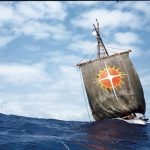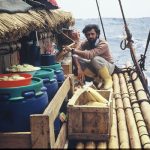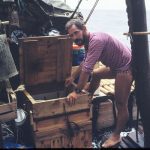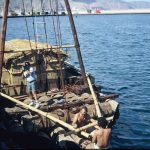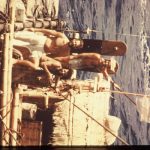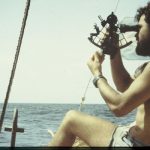Watch the complete documentary on YouTube here.
In 1984 five Argentinians crossed the Atlantic Ocean on a rudderless
raft just like the Africans used to sail over 3,000 years ago.
The idea for this adventure would come from a book that the leader of
the expedition, Alfredo Barragán, had read as a young child: “The adventures
of Kon Tiki” by Thor Heyerdahl. In this novel, the writer tells the story
about his 1947 voyage on a replica he made of an old Polynesian raft
known as Kon Tiki from El Callao, Perú, all the way to Polynesia in an
attempt to prove that thousands of years ago Polynesians had reached
America.
Barragán had heard about the discovery of some basalt statues made by
the Olmeca tribe in the Gulf of Mexico. These statues, which date back
3,500 years and are named “Cabezas Colosales” and referred to as
the Olmec Colossal Heads, reveal numerous quite distinct African
features that are believed to have come from Africa via the Atlantic
Ocean. “Africans sailed along the coast with the help of ocean currents
on rafts made out of tree trunks held together with vegetable-made ropes,
no helm and a sail made of fiber. I always wondered if it would have
been possible for any of these rafts- willingly or not- to have made
it all the way here,” explains Captain Barragán.
So, almost forty years after Heyerdahl’s voyage, Barragán and a group
of four venturous Argentinians set out to emulate the heroic feat of
the Norwegian sailor, to prove that Africans had sailed to America some
3.500 years ago.
The expedition was formed by Alfredo Barragán, Jorge Manuel Iriberri,
Oscar Horacio Giaccaglia, Félix Arrieta and Daniel Sánchez Magariños.
The first three members would eventually get together again to cross
the Caribbean Sea on kayaks, and they all now joined this endeavor because
of its challenge and scientific appeal, and also for its universal positive
message: “Men need to know that they can achieve whatever they set their
minds to”.
The Atlantis raft took five months to build by very simple means: nine
Ecuadorian tree trunks lashed together with vegetable-made ropes, with
a bamboo deck cabin and a wooden mast flying a single linen sail. In
1983, Barragán, Iriberri and Arrieta traveled to Ecuador in search of
the right trees to make the raft, similar to those that grew in the African
savanna. They delved deep into the heart of the jungle and brought back
to a boatyard in Mar del Plata, Argentina, twenty 57 feet long trunks
that together weighed 35 tons. Only nine of these twenty trunks would
be used to build the raft, which would carry a bamboo deck cabin measuring
12 feet long, 8 feet wide and 3.5 feet high.
The raft sported no rudder in the fashion of the primitive African rafts.
The only steering system was sail trim and nine dagger boards that would
allow them to make course changes, making navigation maneuverability
very challenging. As an example they recall the need to start maneuvering
two days before reaching an island, especially if they needed to avoid
it.
Atlantis Expedition departed Santa Cruz de Tenerife, Canary Islands,
on May 22, 1984 and in their first days out sailing on their modest
45-foot long raft with a 5.5 beam they faced a storm with 12′ to 20′
waves. The trade winds and the Equatorial current served as their engine
during the entire trip. The only goods aboard were fresh and bagged food,
400 gallons of mineral water, two 190 lbs. LPG containers, survival rations,
manual desalinators, VHF and SSB radios, a compass, sextants and nautical
charts.
They faced a second storm along the American coast and forty days into
the expedition they could see the first signs that Atlantis was approaching
land: branches and oil stains floating nearby. The current had pushed
Atlantis towards the Venezuelan port of La Guayra and on July 12, thousands
of people welcomed them ashore. It had taken them 52 days to cross over
3,000 nautical miles.
Remarkably, in spite of having an extremely rudimentary steering type,
the Atlantis crew amazingly remained within 20 nautical miles of the
projected course. “This is proof that anything that drops in the water
and floats off the Canary Islands will drift towards the Caribbean. This
usually takes four to five months and of course with a sail even less,”
explained Captain Alfredo Barragán.
It’s worthy to remember their feat after all these years and Barragán’s motto,
the wise and humble words he pronounced upon his arrival in America:
“Men need to know they can achieve whatever they set their minds to”.
